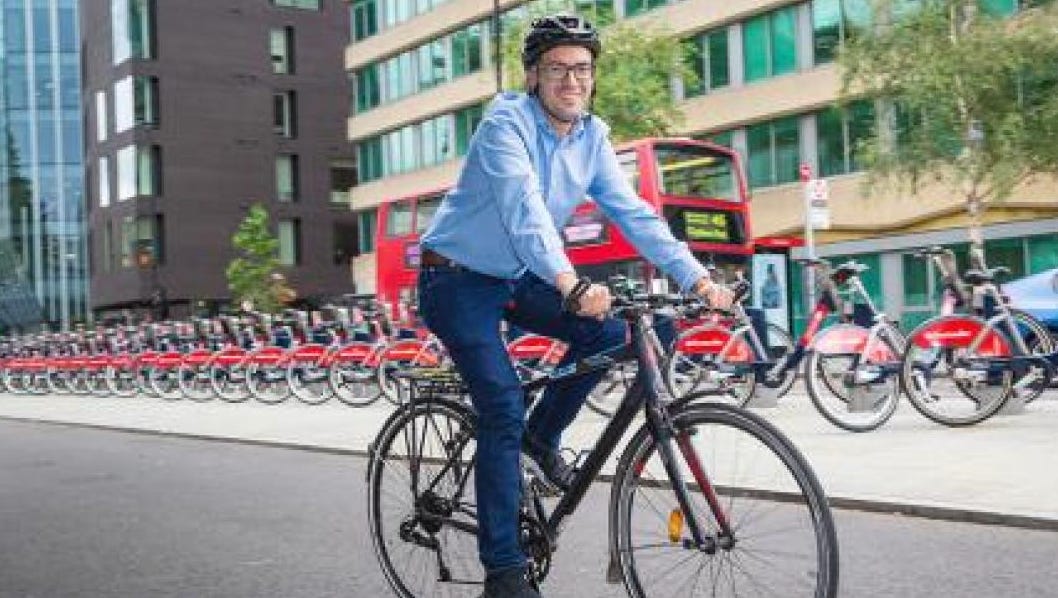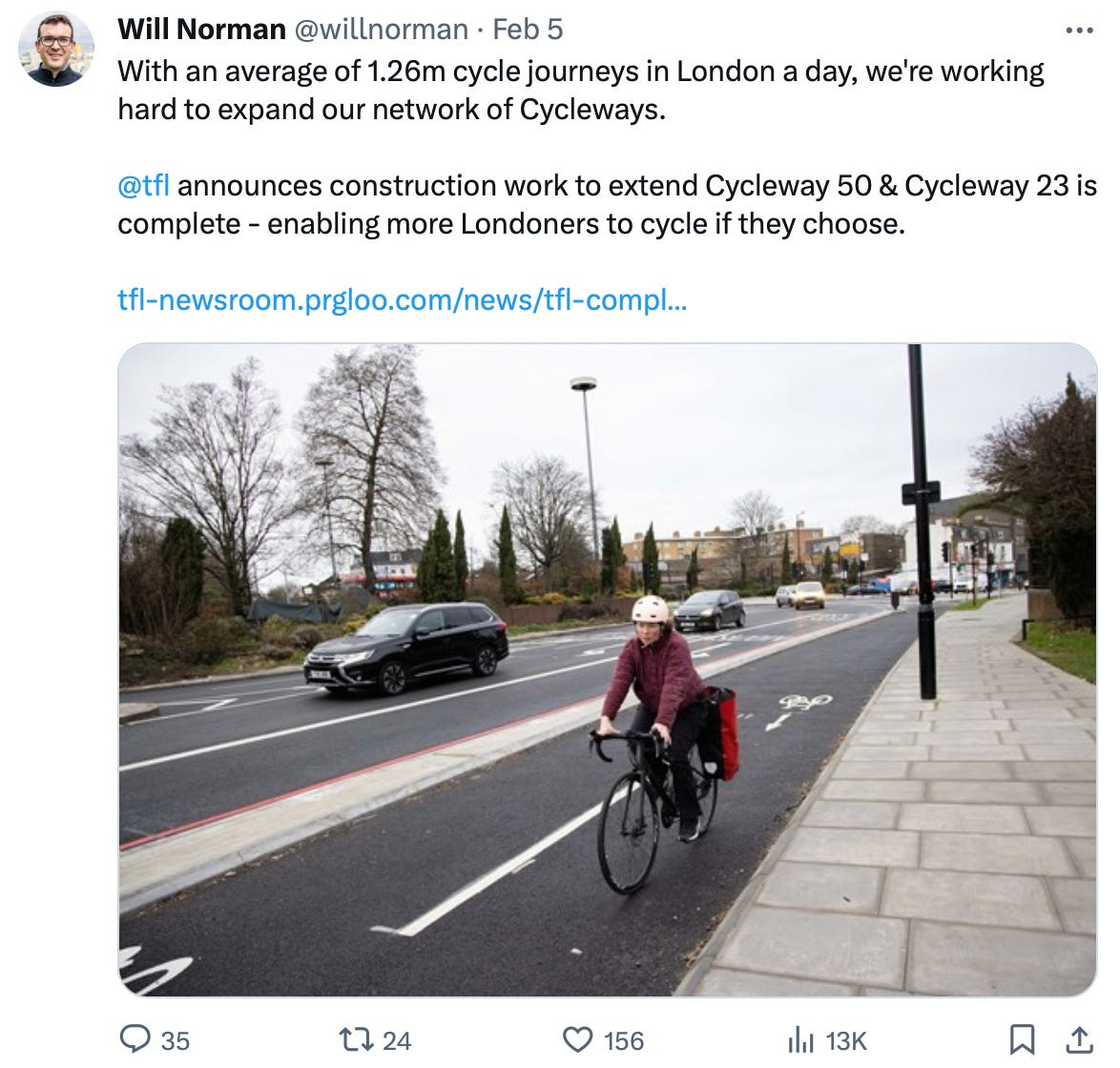Who is Will Norman?
Meet London's Walking and Cycling Commissioner paid £110,000-£114,999 per year
If you went out onto the street and asked most Londoners who Will Norman was, I doubt many would have a clue. While some have very strong views on Sadiq Khan, Norman might evoke the reaction “who?” I tested this theory on a plumber this morning - he and I had a long chat about politics the same time last year when he inspected my boiler - who indeed had never heard of Norman.
The strange thing is that after Khan, Norman’s impact on London is perhaps the most pronounced; maybe even more noticeable by virtue of the fact his policies are physical/material, and can be experienced by anyone moving about the capital.
Norman’s appointment, 2016
After becoming Mayor of London in May 2016, Khan recruited a series of czars, such as the pointless Amy Lamé (more on her here).
Norman became “London’s first Walking and Cycling Commissioner”, initially on a salary of £98,000 (paid by TfL), now £110,000 - £114,999. Since then he has transformed London into something of a playground for cyclists - “LycraLand”, if you will - all the while maintaining a low profile and little scrutiny from the press (hence the impetus for this post).
Before becoming the Walking and Cycling Czar, Norman was Director of Global Partnerships at Nike and worked “with not-for-profits, governments, UN agencies and European Institutions to tackle the global inactivity crisis”. He also “established a successful social research consultancy”.
None of this exactly suggests Norman is an expert in transport planning - which is effectively what he has been given a mandate to do in the capital. His own LinkedIn shows some of his activities at Nike were working on how to “increase levels of physical activity and participation in sports around the world”, hardly the same thing as understanding the movement of transport around urban spaces.
The London Assembly makes it clear that Norman is also a Dr.
What expertise, dear reader, could this PhD reflect? Might this hold the clue to why Khan chose him to be London’s “Walking and Cycling Commissioner”?
It turns out Norman is an expert in “Politics, Migration and Transfrontier Conservation in the Mozambican Villages of the Mozambique-South Africa Borderland’”, and before that the “responsibilities of academics in public discourse” when representing Rwanda.
There’s nothing wrong with these degrees, per se, I should add - although the second is emblematic of the Western education system’s over-supply of courses the economy doesn’t need (not to trivialise the terrible subject matter, but how many jobs require an expert on British press coverage of the 1994 Rwandan crisis?) - but the point is they have nothing to do with London transport.
Even so, Norman has had an extraordinary impact on London in ways most people perceive every day, but don’t necessarily realise is one man’s doing.
Lycra lovin’
The main thing to understand about Norman is that he simply loves cycling.
In addressing transport needs, the question for him is never “how can I make things work for Londoners?” But “how can I make sure the capital is designed for me and my fellow cycling aficionados?”
Like other fanatical cyclists, I don’t think Norman can even compute the fact that not everyone likes cycling. It’s like trying to explain why humans go the theatre to an alien.
Low traffic cycleways
One Norman’s favourite bits of infrastructure is “low traffic cycleways”. TfL describes these as “Cycleways are high-quality cycle routes that link communities, businesses and destinations across London”.
Here’s an example of one:
These form a large part of his “Cycling action plan 2” (yes, there is already 1), published in 2023. In Norman’s foreword, he reinforces his ambition for “London to be the world’s best large city for cycling”.
You don’t have to understand the various terminology of the Lycra Lobby - including “cycleways” - to get the general idea. Everything is about gutting out infrastructure for cars and replacing it with cycle lanes, so that we can all live happily ever after in a perfect two-wheeled green utopia.
Take Hammersmith Bridge, which has been converted so that only cyclists can travel on it - not something everyone would have been aware was happening.
What’s the problem?
One incredibly serious issue consequence of LycraLand is that London is becoming increasingly inaccessible for people with disabilities and the elderly.
The charity National Federation of the Blind of the UK (NFBUK) has been on a thankless mission to demonstrate how much new infrastructure, including that directed by Norman, have harmed, and continue to harm, those who are blind and vision impaired. (I also wrote this article for The Critic which goes into more depth.)
“Floating bus stops” are one of the worst offenders at creating barriers to travel. They essentially put bus stops in between busy roads and cycle lanes - it’s probably easiest to understand by looking at the the image below.
If a blind/ visually impaired/ disabled/ elderly otherwise vulnerable person gets off at that bus stop, they have much less space to work with - a nightmare if you have a guide dog/ walking stick/ wheelchair/ shopping bags/ and so forth - and additionally run the risk of being knocked into by a cyclist going past.
Despite NFBUK’s valiant efforts, which include blind people demonstrating and articulating (see below) why they are struggling with the new infrastructure, Khan’s administration has pretty much blanked them - and, indeed, carried on with installations that limit vulnerable groups’ independence.
Here is an example of NFBUK trying to engage Norman, and getting nowhere - even though Norman is the “Walking and Cycling Commissioner” - aka, he is also meant to be supporting people with the former too.
The second big issue is that cycling infrastructure is increasing congestion.
If anyone points this out on Twitter, incidentally, Cycling Psychos (men who get extremely offended if you criticise cycling), will ask to see data of how this is happening.
But the evidence is everywhere. Step outside central London and you can see queues of traffic. Anyone with common sense knows that if you shrink the roads, while demand for car use remains the same (because - shock, horror! - not everyone can cycle to work) - you will gridlock areas and increase pollution levels.
Furthermore, it seems a sure-fast way to slow down emergency services.
Last year it was found that Low Traffic Neighbourhoods (LTNs), infrastructure the Lycra Lobby can’t get enough of, delayed 240 ambulance callouts for potentially life-threatening injuries or conditions in London.
That same year the London Ambulance Service (LAS) even got into a dispute with Greenwich Council, after the latter proposed to introduce new LTNs. The council reportedly claimed the scheme would help improve emergency services attendance times, where the LAS, backed by the Fire Brigade and Met, said the use of “modal filters” (such as lockable bollards to keep cars out) “have the potential to impede our response to the most critically-ill people.”
Militant cyclists all-too-often simply expect people to ignore reality, or don’t even recognise it themselves. We are somehow supposed to believe that turning cities into obstacle courses, where vehicles are constantly trapped and delayed, is good for the environment, and helps the emergency services. If anything, we need a study on how these changes correspond with the national rise in excess mortality.
Expensive travel
Norman’s changes are not only making life harder, and more dangerous, for Londoners; they are expensive too.
Last year Khan approved a budget of £4.6 million “to provide more cycle routes and infrastructure” in London. It’s not obvious that this money is being put towards particularly effective initiatives (I intend to do another piece in the future on some of these).
Conclusion (for now)
This is just the tip of the iceberg in understanding how the Lycra Lobby - who oversee a system in which funds go back and forth from taxpayer, cycle groups and elected (and unelected) bureaucrats to alter transport - now dominates London policy. In short, an unelected man who loves cycling has been given carte blanche to re-write the capital’s infrastructure without any obvious experience or the democratic mandate to justify the changes, nor any ostensible interest in opposition to the plans.
I will be doing a series more articles on Norman and other issues with Labour-run London in due course - seeing as the rest of the media seems utterly uninterested!
On yer bike, for now!
















Hammersmith Bridge has been closed to all traffic for ages pending stabilisation and repair work, as you no doubt know.
The structure was stabilised enough to allow pedestrian traffic over the side footways.
I understand that during a pause in the stabilisation works, temporary arrangements have been made to allow cycle traffic over the main carriageway.
That's a benefit to cyclists, who otherwise have to wheel their bikes over the pedestrian footway.
Hammersmith and Fulham Council plan to reopen the bridge to *all* traffic following a project to install a temporary carriageway between the bridge piers.
There are some either side of the river who would rather the bridge remained bike-only: but AFAIK neither LBHF or City Hall have advocated this.
You express concern that cycling infrastructure increases congestion and pollution, suggesting that reducing road space for cars leads to gridlock. Contrary to this view, studies indicate that well-designed cycling infrastructure can alleviate (or at least not increase) congestion. For instance, research from Imperial College London found that London’s Cycle Superhighways have minimal impact on traffic speed, suggesting they don’t exacerbate congestion.
https://cyclingindustry.news/cycle-superhighway-lanes-have-little-impact-on-congestion-finds-data-study/
Also see https://en.wikipedia.org/wiki/Induced_demand